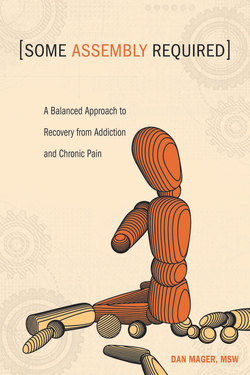Читать книгу Some Assembly Required - Dan Mager - Страница 15
На сайте Литреса книга снята с продажи.
Оглавлениеchapter five
[A PERSONAL PRISON IN] PRIVATE PURGATORY
“A man who carries a cat by the tail learns
something he can learn in no other way.”
MARK TWAIN
---------------------------------------------------------------
No one expects to become addicted to drugs (or anything else for that matter). Nobody ever plans to become an addict. Addiction is an insidious and patient disease. Although it overtakes some people with great speed, pinning them to the mat in a matter of a few short months or in some cases weeks, usually it bides its time. Addiction can pull people in slowly; its seduction so gradual that people often have no idea they’re falling under its spell. In Greek mythology, the Sirens were fabled seductresses whose enchanting songs lured sailors on nearby ships to their deaths.
The sailors were so entranced that they never knew they were in danger until their vessels crashed against the rocky coast of the Sirens’ island and sank. So it is with addiction; by the time most people have any clue that they’re in trouble, they’re already in too deep.
What began for me as an intermittent path to pleasure, as well as a transitory escape—initially from the stresses of life, and subsequently from emotional and physical pain—grew into a dogged preoccupation that over time metastasized into an obsession and a ruthless compulsion. I started out gently floating on a raft off a beach in the Caribbean and ended up being blown out to sea and lost in the middle of the ocean during a typhoon. My using began as a vacation and turned into a kidnapping, with a compelling case of Stockholm syndrome.
---------------------------------------
After completing my master’s degree, I became credentialed as a Certified Social Worker in New York State (licensure was not yet an option) and went to work as a therapist at an outpatient psychiatric clinic for adolescents and young adults. The Youth Counseling League was located in a brownstone on 19th Street around the corner from Third Avenue in the Gramercy Park section of Manhattan. The approach to psychotherapy there was explicitly psychodynamic—an offshoot of psychoanalysis and psychoanalytic psychotherapy. The attention to supervision and training was phenomenal. The agency provided an intensive training program in psychodynamic theory and practice. It was like working at a postgraduate institute.
As rich as the learning environment was at the Youth Counseling League, the commute absolutely sucked. My wife and I lived in a basement apartment at my in-laws house in Fort Lee, New Jersey, so I would take the bus over the George Washington Bridge to 175th Street in upper Manhattan, where I would get on the subway and take the A train down to 14th Street, transfer to the L train and take that to Union Square, from which I would walk the handful of blocks east. After work, I would reverse the same route. It took about ninety minutes each way, and that was when the mass transit system functioned well. When it didn’t, the trip could, and often did, take two hours or longer.
Our first daughter was born in the fall of 1987, shortly after I started at the Youth Counseling League. Watching her enter the world, I knew that my life and my priorities would never be the same. I was twenty-eight years old and felt nowhere near ready for my new role as a parent with its profound responsibilities. I came into it with an awareness of the downside—the challenges as far as how much time and difficulty parenting would likely involve. What I had absolutely no sense of, until I experienced it directly, was the breadth and depth of the rewards I would receive in trade. The connection I felt upon meeting my daughter transcends my ability to describe it. I experienced a love beyond anything I had ever known.
I gravitated toward employment closer to home and closer to an area of work with which I was intimately familiar, though not yet from a professional perspective: substance abuse. Less than two years removed from my master’s program, twists of fate put me in the clinical director’s position at Network, a residential substance abuse treatment program for adolescents in Rockleigh, NJ, a scenic twenty minute commute by car. There was no way in hell I felt ready for such a huge step up the career ladder, but the executive director strongly believed in me and, as brief as it was, my prior training and experience had prepared me well. The 25 percent jump in salary wasn’t exactly a disincentive either.
The program had access to a gymnasium with a basketball court for client recreation. Although specific staff was assigned to supervise recreational activities, I made it a point to play hoops with the clients when my schedule allowed. I dubbed this treatment method “court counseling.” It was a decidedly nontraditional though effective way to establish and deepen relationships with clients, particularly those who were standoffish and difficult to reach.
